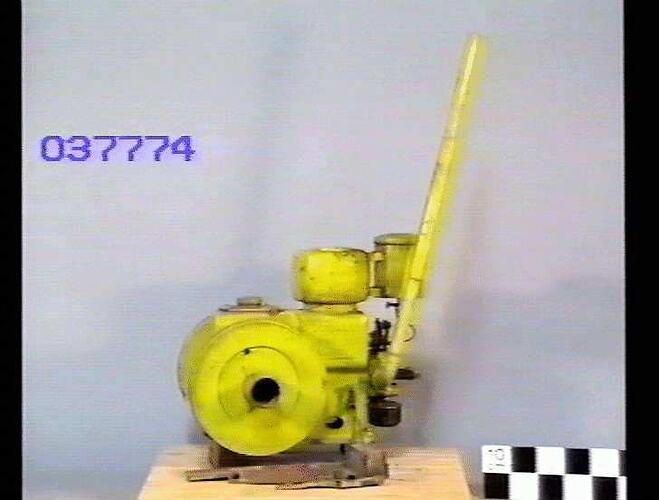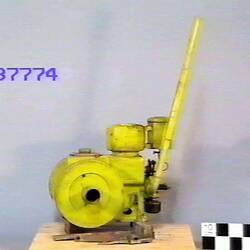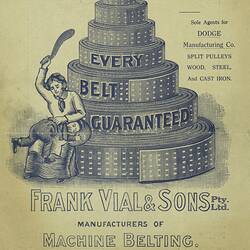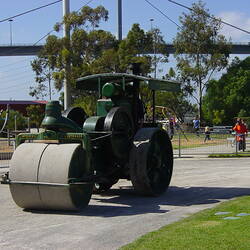Summary
Horizontal single-cylinder hooper-cooled semi-diesel compression-ignition stationary internal combustion engine, designed to operate on kerosene, light crude oil or diesel distillate. Imperial "Super Diesel" SE-Type model, Serial No.3686, rated for 2½ horsepower (1.86 kW) at 600 r.p.m. Manufactured by A.H. McDonald & Co. Pty Ltd, of 570-574 Bridge Road, Richmond, Victoria in 1944.
Formerly used by Melbourne & Metropolitan Board of Works (M.M.B.W.) as the motive power for a 'Litta 650' portable pumping plant.
SE-Type "Super Diesel" engines were manufactured at McDonald's Imperial Engine Works, Richmond, Victoria, from 1939-1942. The design was based on the earlier S-Type "Super Diesel" engine first introduced by McDonalds in 1931, and was the smallest sized engine in the firm's "Super Diesel" range. The SE-Type design featured an enclosed crankcase and valve timing gears and solid disc flywheels, giving the engine a cleaner overall appearance than the earlier "Super Diesel" engines that had open crankcases spoked flywheels. McDonald "Super Diesel" engines all used the Brons or Hvid type fuel injection and were manufactured from 1918 to 1950, with a total of over 20 different designs made in eight different model sizes - ranging from 2 to 20 horsepower (1.47 to 14.7 kW). The SE-Type was the most succesful model with the total production of 3,338 units representing over a quarter of all "Super Diesel" engines built by McDonalds.
Physical Description
Self-contained single-cylinder horizontal stationary crude oil engine painted yellow-green, with tall vertical stand-pipe exhaust. Specifications: Bore x Stroke: 3½-inch x 5-inch (88.9 mm x 127 mm) Power Rating: 2½ brake horsepower (1.86 kW) at 600 r.p.m. Crankshaft: 1 5/8-inch diameter Flywheels: Two solid disc type of 20-inch diameter x 2 3/8-inch face x 3 5/8-inch deep rim Belt Pulley: 4½-inch diameter x 4½-inch wide Fuel Tank: 7-inch diameter x 9-inch high Exhaust Pipe: 2-inch diameter x 66½-inch high Top Water Hopper: 12-inch x 9½-inch oval shaped x 9¼-inch high, with 6½-inch diameter hole in top Holding Down Bolt Hole Centres in Bottom Flange of Crankcase Casting: 21¼-inch x 8-inch
Significance
As a general class of objects McDonald 'Super Diesel' engines played an important role in introducing mechanisation to a wide range of construction and rural industries throughout Australia with their low running costs and ability to operate on a variety of low grade fuels being particularly important to their success. They also played a key part in establishing the Australian manufacture of reliable diesel engine designs. Built in eight different sizes ranging from 2 to 20 horsepower, the McDonald 'Super Diesel' engines were manufactured from 1918 to 1950, with almost 13,000 engines produced in total, making them one of the most successful types of stationary internal combustion engine ever made in Australia. All of McDonald's 'Super Diesel' engines used the Brons or Hvid fuel injection system with compression ignition. The Brons system was originally invented by the Dutch engineer Jan Brons (1865-1954), however, McDonalds obtained the design from the United States, where the Danish-born engineer Rasmus Martin Hvid (1881-1950) applied for a patent on a combustion system in 1912 that appears to have been largely based on the Brons design. Hvid subsequently licensed the use of his improved Brons injection to several American engine manufacturers including the St Mary's Machine Co. of St Mary's, Ohio (llater known as the St Mary's Oil Engine Co. of St Charles, Missouri), from whom McDonalds copied both the brandname and design of their first "Super Diesel" engines.
A.H. McDonald & Co. were a notable Australian business, being one of the country's leading specialist manufacturers of both internal combustion engines, tractors and construction equipment throughout much of the 20th century. The company were one of the first firms to begin the manufacture of diesel engines in Australia and were particularly innovative in both their introduction of new technologies from overseas and the development of improved local designs. They were the first firm to manufacture tractors, petrol powered road rollers and diesel road rollers in Australia. The history of the 'Super Diesel' engine range and its successful production over a twenty year period is indicative of McDonald's general approach to product development and innovation, in which they often began by copying an established and proven overseas design, but then over subsequent years modified the basic design extending the range and capacity of models offered and adapting it to new applications.
More Information
-
Collecting Areas
-
Acquisition Information
Donation from Melbourne & Metropolitan Board of Works (MMBW), Oct 1988
-
Manufacturer
Imperial Engine Works, A.H. McDonald & Co Pty Ltd, 570-574 Bridge Road, Richmond, Greater Melbourne, Victoria, Australia, 1944
-
User
Melbourne & Metropolitan Board of Works (MMBW), Melbourne, Greater Melbourne, Victoria, Australia, circa 1940s-1970s
-
Inscriptions
Cast in raised lettering onto exhaust side of cooling water hopper: 'McDONALD / CRUDE OIL / "Super Diesel"' (last two words in italics) Cast in raised lettering onto oval shaped maker's plate on screwed to value push-rod side of cooling water hopper: '[ READ / INSUTRCTION BOOK ] / Imperial / "Super Diesel" / ENGINE No.3686SE / A.H. McDONALD & Co. PTY. LTD., MELBOURNE' (Title Case words in italics) Cast in raised lettering onto round inspection cover surrounding oil dip-stick hole on crankshaft end of crankcase: 'DRAIN WASH / REFILL / REGULARLY' Stamped into top edge at crankshaft end of crankcase casting: '3686' Stamped into top plate on crankcase close to oil filler hole: '208 SH' Printed in italic lettering on rectangular plate with rounded corners attached to pressed metal guard associated with pumping unit: 'Litta 650'
-
Model Name or Number
-
Brand Names
-
Classification
Mechanical engineering, Internal combustion power, Oil engines
-
Category
-
Discipline
-
Type of item
-
Overall Dimensions
915 mm (Length), 700 mm (Width), 835 mm (Height)
Height measured to top of water hopper - excludes height of exhaust pipe.
-
Overall Dimensions
36 in (Length), 27.5 in (Width), 32.75 in (Height)
Height measured to top of water hopper - excludes height of exhaust pipe.
-
Keywords






